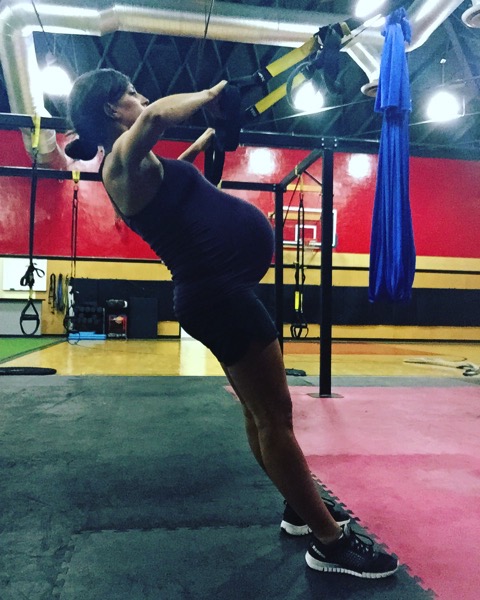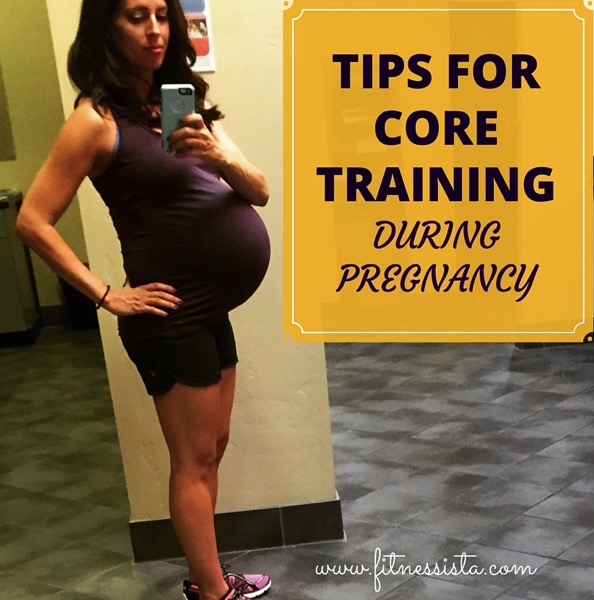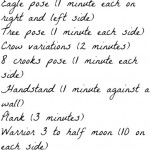Core Training During Pregnancy
aka tips as you work your way to a reverse six-pack 😉

Core training during pregnancy was something that I was totally clueless about when I became pregnant with Liv. I did as much research as possible, and at the time, was teaching in Tucson at a health/fitness resort (so I had a lot of amazing resources to ask!), and was able to determine a few hard and fast rules for core work during pregnancy. I also have an incredible resource here in San Diego: my good friend Jess, who is a Physical Therapist, Certified Pilates Teacher and group fitness instructor. She also posts workouts on her page, and has her own fitness DVD series. Basically, she’s a rockstar. Thank you, Jess, for collaborating with me on this post!
Guidelines for Core Work During Pregnancy
1) No supine or prone exercises after the first trimester (this is in line with ACOG’s recommendations)
2) Stay away from crunches, or exercises that target the rectus abdominis (your “six pack” muscle)
3) Instead, work on strengthening the deep transverse abdominis through stabilizing exercises like planks (as long as they feel good).
4) Avoid overtaining the obliques. During pregnancy, your abdominal muscles separate to make room for the baby. After the baby is born, they will work to go back to place. If you’re overtraining your obliques, you can essentially train your muscles to pull apart farther. We don’t want these muscles to get insanely strong during pregnancy; wait until after baby is here!
Why is Core Training Important During Pregnancy?
-It can help prevent back pain. This is critical during pregnancy and afterwards. Late night nursing sessions, carrying the baby, and what I call the “mom reflexes” (<— quickly twisting, squatting, reaching, and doing whatever you need to do to prevent a crisis), are all supported by a strong core. If your core remains strong, it’s less likely to cause back pain as you move through the daily activities. A strong core also helps prevent sciatica, which many pregnant women suffer from.
-It promotes healthy posture. Posture changes during pregnancy, as the center of gravity shifts and you’re walking around with a bowling ball attached to your waist. By training your core, you will more likely be able to safely adjust for your various stages of posture as the baby grows.
-Helps prevent incontinence during and after pregnancy (no peeing when you sneeze) 🙂
-Helps us get through labor and delivery! It’s an athletic event, and the more you keep your fitness levels up, the more endurance and strength you’ll be able to maintain during such a physically grueling event
-Helps us return to pre-pregnancy fitness levels faster after baby comes
Core Exercises You Can Do During Pregnancy
(pending doctor approval and if you were doing them pre-pregnancy. Pregnancy is not the time to do anything new in your routine):
-Deadlifts (you may need a wider stance)
-Marches (on your back or incline on a bench)
-Planks (modify as needed on your knees)
-Cat/cow
-Spinal balance
Pelvic Floor Work
Squat your heart out. Kegels were supposed to be all the rage, until recent research suggested that they could shorten the pelvic floor muscles and causing potential difficulty during birth. (This is a fantastic post about it!) Instead, squats are now heralded as a safe and effective way to strengthen your glutes and lengthen the pelvic floor muscles during pregnancy. Because your center of gravity is shifted, stand next to a wall or hold onto a chair for balance if you need it. Go as deeply into the squat as you feel comfortable. My chiropractor told me that deep yoga squats are awesome for the end of pregnancy, as it helps baby get into a good position for birth.
Core Training After Birth
This is when it’s a good time to start doing kegels. Ina May Gaskin says you should do kegels the day you give birth!
Ease back into core training and wait until your abs are no longer separated. (Here is a helpful video on checking for diastasis recti and if your abdominal muscles are still separated. If they are, talk to your doc before core training and Physical Therapist for assistance with healing.)
Start with stabilizing work (planks), and move into rectus abdominis and oblique work later.
My Post Baby Bod program has a ton more information on how to safely and effectively shape up after baby. Check it out here!
Most importantly:
Honor your body. It will tell us what it needs, and it’s up to us to listen. If something feels great (and the doc gave you the ok!), keep on doing it. If something starts to feel uncomfortable or wrong, it’s an excellent time to stop and adjust.


















Yay! I felt a little bad for not doing the kegals my pregnancy app reminds me to do every day, and now I’m off the hook!
I’m a Pilates instructor and am suuuuuuper lucky to have a reformer at home, which helps keep various kinds of core strengthening accessible and safe through pregnancy (lots of my clients come to classes through their entire pregnancies and just roll with modifications to match their body changes–amazing!). I’m 14 weeks along with my first, and this is a super helpful reminder to keep my core strong without going bananas for the next several months.
One exercise I really love for transverse abdominis that I don’t see mentioned is pelvic curls, either seated or supine. They feel great and are safe all the way through as long as you don’t get too crazy.
Thanks for this great post, ladies!
I appreciate this! I did a LOT of core work before getting pregnant and I’ve cut back on most of it (17 weeks now). I still do a few things my physical therapist recommended and plank is one of them. I go to yoga once a week (will probably start doing it 2x a week soon) and I’m finding certain poses more difficult–especially cat and cow, which is weird. I never thought of it as a core exercise, either, but spinal balance definitely is. That one is still doable for me!
I’ve been hoping for this post as I just found out we’re expecting a little one 🙂 (number two!!!). Thank you! And all the best on L&D for your sweet one on the way xo
Oh my gosh…I’m so incredibly excited that you posted that article about kegels. I mentioned a book called Move Your DNA to you awhile ago and Katy Bowman (referenced in that article) is the author. I’m currently studying to be a Restorative Exercise specialist through her institute! Sorry I’m just very happy that information is becoming more mainstream. I know so many people are (positively) influenced by your fitness advice so I love seeing you put that out there! Thanks 🙂
This is a great post for getting some ideas on how to work your core through pregnancy. I’ve been keeping up with core work, going to barre & modifying abs and unfortunately that did not spare me from sciatica :-/ I had it starting early in my second trimester too. What did help was the chiropractor. I was seeing a PT about pelvic floor issues long before I became pregnant and she advised me NOT to do kegels, that having too strong of a pelvic floor was causing the issues I was having. But to do definitely do them after childbirth.
I love the message this sends. I think a lot of people get pregnant and their core becomes dead to them as their belly grows – they just sit back and let it do its own thing. But something one of my prenatal yoga instructors sometimes reminds us while we are doing gentle core strengthening work is, “Use your core, you DO still have one.” which really hits home for me. Just because I am growing a baby doesn’t mean I should take 9 months off my core altogether. Thanks for listing out some preg – safe movements!
Loved this post. There’s really little information on core workouts, or what’s out there is contradicting. I was doing yoga pre-pregnancy, and I’ve kept doing yoga specifically for prenatal exercises and love it. The best part is that there are so many modifications to it that you don’t need to go into a deep stretch if you’re not feeling it. Had never heard of Marches, so I’ll defnitely have to look those up.
Thanks!
You are so inspiring girl!!
What are your thoughts are contracting your core throughout the day and while walking? I’m in my second trimester and I’ve been told it’s bad and that it’s good………
i would talk to your doc, but i personally think it’s fine. i wouldn’t go crazy with it, but it’s natural to do to protect the back and help with posture
Love this post! Can you be more specific on which exercises to avoid- like define #1?
sure! avoid any exercises flat on your back, or on your stomach. so for the supine exercises, try an incline bench. for the prone exercises, many of these can be done on your hands and knees instead.